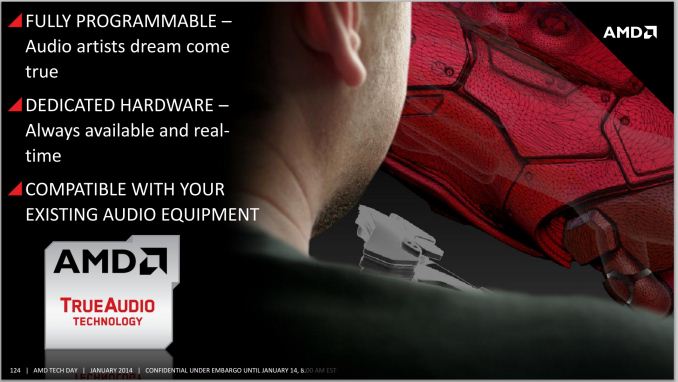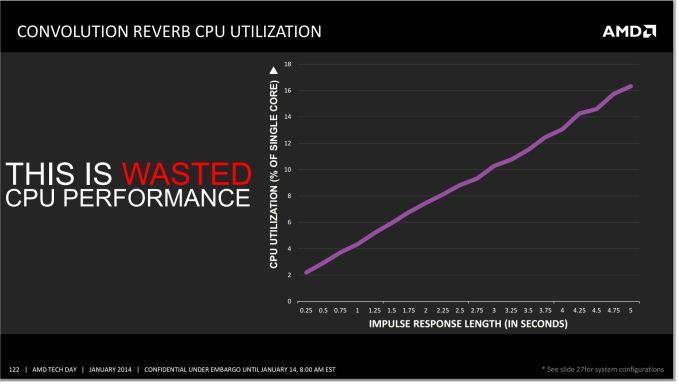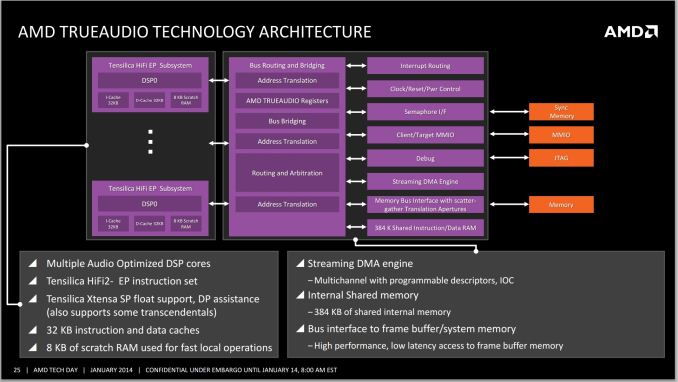AMD Kaveri Review: A8-7600 and A10-7850K Tested
by Ian Cutress & Rahul Garg on January 14, 2014 8:00 AM ESTTrueAudio
As part of the Kaveri package, AMD is also focusing on adding and updating their fixed function units / accelerators. Due to the jump on the GPU side to GCN we now have the TrueAudio DSP to allow developers to increase the audio capabilities in game, and both the Video Codec Engine (VCE) and Unified Video Decoder (UVD) have been updated.
All the major GPU manufacturers on the desktop side (AMD, NVIDIA, Intel) are pushing new technologies to help improve the experience of owning one of their products. There are clearly many ways to approach this – gaming, compute, content consumption, low power, high performance and so on. This is why we have seen feature like FreeSync, G-Sync, QuickSync, OpenCL adoption and the like become part of the fold in terms of these graphics solutions.
AMD’s new feature is TrueAudio - a fully programmable dedicated hardware element to offload audio tasks to.
The main problem with developing new tools comes down to whether they should be implemented in a general fashion or with a dedicated element. This comes down to the distinction of having a CPU or an ASIC do the work – if the type of work is specific and never changes, then an ASIC makes sense due to its small size, low power overhead and high throughput. A CPU wins out when the work is not clearly defined and it might change, so it opens up the realm of flexibility in exchange for performance per watt.
CPUs are now significantly powerful that a range of audio based techniques are available to them and the algorithms are optimized. The only limitation in this regard is the imagination of the developer or audio artist, which actually becomes part of the problem. When implementing an audio filter on the fly to a video game, the processing via the CPU can be overly taxing, especially when the effect is persistent over a long time. The example AMD gave in their press slide deck is one of adding reverb to an audio sample. The longer the reverb, the bigger the draw on CPU resources:
AMD cites this CPU usage as the effect of one filter on one audio sample. Imagine being in a firefight situation in a video game, whereby there are many people running around with multiple gunshots, splatter audio and explosions occurring. Implementing effects on all, and then transposing audio location to the position of the character is actually computationally expensive, all for the sake of realism. This is where the TrueAudio unit comes into play – the purpose is to offload all of this onto a dedicated bit of silicon that has the pathways built in for quicker calculations.
TrueAudio is also implemented on AMD's latest-generation R9 260 and R9 290 video cards – basically anything at least GCN 1.1 and up. Meanwhile we also know that the PS4’s audio DSP is based on TrueAudio, though given the insular nature of console development it's not clear whether the APIs are also the same on both platforms. AMD for their part is working with major audio middleware plugins (wwise, Bink) in order to help develop the TrueAudio ecosystem, so even in the case where the APIs are dissimilar, middleware developers can abstract that and focus on the similarities in the hardware underneath.
As is usually the case for these additional hardware features, games will need to specifically be coded to use TrueAudio, and as such the benefits of TrueAudio will be game specific. At the same time there are not any games currently on the market that can take advantage of the feature, so the hardware is arriving before there is software ready to use it. The first three games on AMD's list that will support TrueAudio are Murdered: Soul Suspect, Thief, and Lichdom. Much like FreeSync, I expect the proof is in the pudding and we will have to wait to see how it can affect the immersion factor of these titles.
Unified Video Decoder and Video Codec Engine
I wanted to include some talk about the UVD and VCE with Kaveri as both are updated – we get UVD 4, an update to error resiliency for H.264, and VCE 2, as shown below:
Of the two blocks, the improved VCE has the more interesting improvements to discuss. With the addition of support for B frames in H.264 encoding, the resulting ability to do backwards frame prediction should help improve the resulting image quality from VCE and/or reduce the required bitrates for any given quality level. Meanwhile the addition of support for the higher quality YUV444 color space in the H.264 encoder should help with the compression of primarily linear lineart/text, which in turn is important for the clarity of wireless displays.





















380 Comments
View All Comments
Fox5 - Wednesday, January 15, 2014 - link
There's also the issue of the Iris Pro's 128MB edram. At a certain point, it probably is insufficient for the settings and resolution.BSMonitor - Wednesday, January 15, 2014 - link
Power consumption numbers?? Interesting to see what adding that many transistors (particularly 128 GPU cores did to those)Da W - Wednesday, January 15, 2014 - link
242 comments so far. Whatever people say, AMD still interests a lot of people and they have a future ahead of them.thomascheng - Wednesday, January 15, 2014 - link
Lets hope they do well, or we will be stuck with buying $1000 Intel CPUs and Nvidia GPUs.TheJian - Wednesday, January 15, 2014 - link
"For casual gaming, AMD is hitting the nail square on the head in its quest for 1080p gaming at 30 frames per second, albeit generally at lower quality settings."Maybe if they'd said for 1280x1024 gaming your comment would be true. Most of the games have mins at 1080p well below 20, and some even avg below 30. This resolution is NOT playable on these crap chips. Buy a vid card and Intel. Period. I really thought these would be faster, but then the downclock due to process happened. Gains in games where you are STILL unplayable isn't a gain. It is a waste of space to benchmark things you can't actually play at. I would rather have seen a dozen games benched at 1280x1024 and a few you KNOW you could run above 30fps at 1680x1050. 1080p here was pointless. AMD should be derided for even mentioning this res with so many games not even playable at avg fps never mind what happens when you click the MIN button in your charts.
Discrete clearly has long legs, as anyone building one of these machines with the new APUs will quickly realize they need to buy discrete to enhance their gaming. I really don't think the dire situation here at 1080p will change until 20nm or more, where you may at that point have MORE games that CAN run 1080p ok, vs what you see here where it's just a joke today.
The games don't even look the same when turning off every feature possible in the game just to hit 30fps. Do you want your games to look like a nintendo 64, or a PC? They should have grown the die a bit for more gpu, so at least 1680x1050 would be pretty good. I don't see AMD making money on cpus for 2yrs :( That means consoles + gpus have to hold the company up and that won't be enough to keep up with R&D in mobile, gpu, cpu. Consoles sold 7mil so far, so at $10-15 per chip ($100 price? per console assuming 15% margin? if they even get that) we're talking about a max of 105mil profits from consoles for the quarter. If they don't keep selling like it's launch month for the next 12 months I see them slowly getting weaker. They owe GF 200mil, so 4 of these console quarters would be ~400mil which is 1/2 blown on GF fines, and the other 200mil goes to interest on their huge debt each year. They need to make some REAL money on cpu/gpu/mobile or this never gets better right? We know cpu is basically out for 2yrs as they say in this article. OUCH. So gpu/mobile has to make something in those two years or this just gets worse and drivers etc will see more phase 1, 2, 3 fixing crap for ages.
The only impressive thing I saw here was Mantle perf claimed by AMD in BF4. But how many times can you afford $8mil to get this done? I'm sure they amped things up for the first time showcase BF4, but how many times can you even afford $2-4mil for this stuff? And then do you get what the dev said in the AMD APU show (only one BTW), a 20% not being unreasonable for your efforts? Far below $8mil for apparently 45% in BF4 right? Devs will opt for the 2weeks to transfer a game to MOBILE first as NV showed can be done with any openGL game (all ps3, ps4 games, many pc games etc) like Serious Sam3 and Trine2 (most of the time according to anandtech was spent on controls, NOT the porting). Unreal 3 engine ported in 4 (yes...FOUR) days by epic/mozilla and it only took 10 people or so. Dice said 2-3 months on mantle. Devs might do 2 weeks just for more sales to a 1.2B unit market on mobile, they will need PAYMENT to do it for Mantle which gets ZERO extra profits (only makes people happy they bought AMD, no extra cash right?). I really hope ARM takes off on desktops, because we currently have an Intel only race and need someone with CASH to fight them. Bring on K1 (and all it's enemies) and all the games for mobile this will create (ported or new, I don't own a ps3 so I'd buy some of those ported that I can't get now). Since we have no real x86 competition any more we need ARM to pick up AMD's slack.
Novaguy - Wednesday, January 15, 2014 - link
Its going to depend on the settings; other reviewers who did 1080p + low to medium settings demonstrated playable frame rates for the a8 but not the intel igps.mikato - Wednesday, January 15, 2014 - link
Ian/Ryan - This seems wrong - "For the 100W APUs at 1280x1024, there is almost no movement between the Richland and the Trinity APUs, except for Company of Heroes" under "IGP Gaming, 1280x1024". In this particular graph, it shows an improvement from Trinity to Richland and then not much improvement from there to Kaveri, except for Company of Heroes.Ryan Smith - Wednesday, January 15, 2014 - link
Noted and fixed. Thank you.tekphnx - Wednesday, January 15, 2014 - link
Looks like a pretty nice improvement for its intended market, namely the HTPC and casual gaming crowd. Calling the onboard GPU decent at 1080p is a laugh though, as other people have said. For 720p, sure, but not 1080p.Prices have shot up from the previous generation, which is unwelcome. And I very much lament the omission of Steamroller from the FX roadmap as an FX owner myself. AMD shouldn't abandon FX... the least they could have done if they're abandoning FX is to include a 6-core Kaveri part at the top end, but it looks like that's not materializing either.
zodiacsoulmate - Wednesday, January 15, 2014 - link
first 4 pages are way better than the last 4 pages :) anyway a great article i read like half an hour